On The Rocks Afterword
I first visited Grand Manan, an island in the Bay of Fundy, in 1989. Willa Cather and Edith Lewis found Grand Manan in 1922, travelling by train to Campobello, Maine, where they caught a ferry to North Head, one of five fishing villages on the island and its main port. My partner and I reached the island the way most people do these days, taking a two-and-a-half hour ferry ride from Blacks Harbour in New Brunswick, Canada. I had only a vague sense of where their cottage might have been on the cliffs overlooking Whale Cove. But within minutes of leaving the dock, we found ourselves taking the first drive to the right after the sign to Whale Cove Inn and bouncing down a single-track, rutted dirt road through the woods to where their cottage once stood.
Neglected after the beginning of World War II when Cather and Lewis felt it too dangerous to travel to the island, their cottage had collapsed. Before Lewis died in 1972, Cather’s niece, Helen Cather Southwick, acquired the land and built a cottage replicating theirs on the same spot. When we arrived, that cottage was empty, its front windows blank, staring east through harsh sunlight toward a fishing weir circling into itself in the Bay below. There were no fishermen and no ships. The place was quiet, almost too quiet, but a trail passing through to the south proved magical, its tall pines and lush grass giving the shade and comfort Cather and Lewis must have experienced more than sixty years before. We sat a long while enjoying their presence and the sound of waves crashing on the rocks more than two hundred feet below.
Whale Cove Inn and Cottages had no vacancies that trip, so we stayed in the son’s bedroom of a private home near Pettes Cove, on the way to Swallowtail Lighthouse. The room had a waterbed, a window facing the cove, and a hallway decorated with a black velour tapestry featuring a painted stag. Breakfast included strong tea and plenty of gossip about local islanders and the island’s fishing industry but almost nothing about Whale Cove or Willa Cather. The next summer and the two that followed, we stayed in Orchardside at Whale Cove Inn. Located a bit farther south and closer to the Bay on the same trail we found that first day, Orchardside is an old guest cottage that Cather and Lewis shared with others during their early years on Grand Manan. It is divided into sections with two separate attic bedrooms, a small kitchen, and a living room made cozy by a fireplace and built-in bookcase. Cather and Lewis’ quarters, downstairs on the north side, consisted of two rooms, one of which faced Whale Cove and held a small writing desk used, I was told, by Willa Cather.
The person who told me was the Whale Cove innkeeper, Kathleen Buckley, who had been a serving girl during the years Cather and Lewis were there. She explained that, for the first three summers, they stayed in Orchardside then built their own cottage in 1926. Other guests also built cottages on land bordering the property of Whale Cove Inn around the same time, Buckley said, all of whom continued to take meals and share in activities at the Inn. The same was true for Cather and Lewis.
It is through my conversations with Buckley, relatives of those other Whale Cove cottagers, and a local woman, Dora McLaughlin L’aventure (who as a teenager in the late 1950s and 1960s retrieved letters, manuscripts, and memorabilia from the deteriorating Cather and Lewis cottage) that I learned about Cather, Lewis, and the women who summered on Grand Manan. The Cottage Girls, the islanders called them. For many years, they reappeared every summer after 1900-1902, when Sally Jacobus, her cousin Sally Adams, Alice Coney, and Marie Felix bought the land, fixed up the house and barn, and invited friends to join them. They knew what they were doing. The first three completed their education at the Boston Normal School of Gymnastics in 1897; Marie Felix graduated from the Boston Cooking School in 1895, a year before its principal, Fannie Farmer, made it famous by publishing her cookbook. Their experiment quickly became Whale Cove Cottages, a summer colony. A women’s summer colony. That was a surprise. Even more surprising, Whale Cove was eventually one of two women’s summer colonies on the island.
Many places, especially in the Northeast, were well known as summer colonies, some for artists, some for religious gatherings, some for the elite who simply wanted to get out of the heat of their cities. Upstate New York was peppered with them, as were Maine, Massachusetts, Vermont, and New Hampshire, where Cather spent several weeks in 1926 at McDowell, a writer’s colony in Peterborough. But a women’s colony, a place where single women gathered again and again for several weeks, even months, each summer? That was unusual. And here there were two, Whale Cove at the north end of the island and The Anchorage at the south end.
The women who frequented these colonies were college-educated Americans well advanced in their careers as librarians, writers, teachers, nurses, social workers, and occasionally artists. Graduates of women’s colleges such as Smith, Simmons, Mt. Holyoke, and Wellesley, they came from New York City, Boston, or elsewhere in New England; others came from the Midwest. Some had inherited money and so were independently wealthy with no need to work. But most did need to work. For them, Grand Manan was a well-earned summer vacation, a time away, a place to relax, read, hike along the cliffs, bird watch, play, indulge in conversation, and be themselves, unencumbered by the demands of their jobs or social obligations. Uninhibited. Free. And among friends.
This is the place and these are the people among whom Willa Cather and Edith Lewis chose to spend the better part of twenty summers. Cather found she could write there. If she needed to be left alone so she could stay in the book in her mind, even when she was not actively writing it, she could. They both enjoyed their cottage and the island’s natural beauty. They could choose to spend time with others. Or not. Their cottage had no phone or electricity or indoor plumbing, but they were comfortably situated. They ate well, whether in the dining room of the main house — where they usually sat at the same table by themselves before joining others before the fireplace—or prepared a simple meal in their own cottage. They enjoyed an evening’s stimulating conversation with friends.
Or not. They had privacy when they chose and as much quiet as they liked. An ideal workplace for a writer.
The guest book at Whale Cove Cottages had long ago disappeared when I asked to see it, but Kathleen Buckley showed me the address book Sally Jacobus used during her last years at Whale Cove (she died in 1947, the same year Willa Cather died), and I began to see why Cather and Lewis were so comfortable there. Of the ninety-seven entries, at least ten were librarians from New York City, one of whom, Frances Overton, worked at the New York City Public Library and is thought to have told Cather about Whale Cove in the first place. But almost any of them could have.
Ethelwyn Manning was head librarian at the Frick Art Reference Library, established in 1920 by Helen Clay Frick, who took an active hand as director and whose name also appears in Jacobus’ address book. According to Kathleen Buckley, Manning’s great friend—a euphemism for life partner—was Katherine Schwartz, a children’s librarian in New York City who made puppets and, reportedly, good whiskey sours. Other great friends, Lucy Crissey and Phyllis Osteen, were also librarians. Lucy Crissey, like Florence Overton, worked at the New York Public Library and then for thirty years at Columbia’s School of Library Science, eventually retiring as Assistant Dean.
Others flocked together in a variety of ways. Nan Peters and Henrietta Quigley, also great friends, were part of the Bird Girls. Along with Frances Covington, Ann McNaulty, and Etta Wedge, they took advantage of the island’s trails to follow in the path of Audubon, whose early studies of birds on the island are still apparent in an extensive collection of stuffed birds at the Grand Manan Museum. Some, like Eloise Derby, who spent her winters in Paris and whose father developed Bar Harbor, had independent wealth. Several taught at private schools or universities; others, like Winifred Bromhall, wrote children’s books and gained a certain amount of fame; still others like Margaret Byington were very well known.
Margaret Byington crossed paths with Cather and Lewis several times but probably did not meet them until Whale Cove. Byington earned her master’s degree in sociology from Columbia University in 1902, the same year Edith Lewis graduated from Smith College and moved to New York City to begin her career as an editor. In 1906, the year Cather left Pittsburgh for New York City and an editorial job at McClure’s Magazine, Byington moved to Pittsburgh and began a case study of poverty in Homestead, the town Henry Clay Frick built to serve his steel mills. She published the study in 1910 as a monograph entitled Homestead, the Household of a Mill Town. In 1910, McClure’s was equally devoted to exposing social wrongs, and by then Lewis had joined Cather on the magazine’s staff. If they had not met previously, Byington, Cather, and Lewis would certainly have known many people in common and shared similar interests.
In fact, the same is true for most of these women. Many were prosuffrage Republicans (not the same party it is today), and some, but certainly not all, were pro prohibition. All were Independent Women. And in the first twenty years of the twentieth century, that designation meant something special. For Edith Lewis and several others at Whale Cove, the concept of Independent Woman was defined by Mary Augusta Jordan, a vivid personality in the Smith College English Department from 1884 to 1921. Jordan published well-received articles on bachelor women and women’s colleges and designed a textbook explicitly for women entitled Correct Writing and Speaking. Hard work, rigorous attention to detail, and ambitious goals were only part of the task: women had to find their own voices. Edith Lewis, who was one of Jordan’s students, graduating from Smith in 1902, found her voice as a professional editor, as Cather’s personal editor, and as one of the top writers for the J. Walter Thompson Advertising Agency in New York City. And after she met Edith Lewis and finally stepped away from the exciting but all-consuming work of producing the monthly McClure’s Magazine, Willa Cather certainly found hers, beginning with O Pioneers!
A younger set of Independent Women frequented The Anchorage, established by Sabra Jane Briggs on the southern end of the island a few years after she first visited Grand Manan in 1922. An extant registry for The Anchorage records forty-five women’s names entered between 1938 and 1955, most returning year after year, often in pairs or with the same group. They, too, were educated, professional women, but more of them hailed from the Midwest and, among those coming from New York, more were from Upstate or Brooklyn or from across the river in New Jersey than lived in Manhattan.
The number of entries in The Anchorage registry fell off during World War II, just as they did at Whale Cove, but unlike Whale Cove, which survived by hosting increasing numbers of tourists—many of them married couples—The Anchorage closed its doors when Sabra Jane Briggs retired. It is now a Canadian Provincial campground, open to the public. The Whale Cove Inn and Cottages still exists because, in addition to opening the Inn to the general public, Sally Jacobus and the Cottage Girls followed a unique strategy. Jacobus, who had no niece, left the Inn to Kathleen Buckley, the serving girl who had grown up on the island and worked at the Inn for years. The rest of the women who, like Cather and Lewis, built cottages surrounding the Inn, left their cottages to nieces. In time, with all of the nieces married and Whale Cove Inn open to the general public, the Inn survived, but the Cottage Girls and their summer colony simply slipped from view.
A final note about the writing: as fiction writers do, I exercised literary license. Occasionally I rearranged facts for the plot’s convenience. Cather and Lewis really did build a stone wall behind their cottage, but it was actually constructed by Oscar Locke and Charles Green, the island carpenters who built their cottage. And none of these events actually happened in 1929. In February of that year, Alice Coney and her sister Grace were killed in an automobile collision at Winter Park, Florida, and for that summer Whale Cove Inn was managed by others. Sometimes what I saw on the island supplied ideas for the novel. Two small, aging watercolors in simple frames were propped on the fireplace mantel of what is now called the Cather Cottage. Oh, said Kathleen Buckley, who was showing me around, Edith Lewis did those. At the time, I simply thought how wonderful then circled back later to take a closer look. The characters of Cather and Lewis I grounded in historical record, and I modeled the women of Whale Cove and The Anchorage on real people. I found a great deal of information on Ethelwyn Manning and Margaret Byington, for instance, but only a cheery little entry in the registry of The Anchorage for Dot Viking Voorhees. The islanders, tourists, and others connected with the mystery are entirely my own creation.
Sue Hallgarth
Corrales, New Mexico
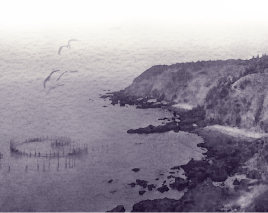 Their Circles Widen
Their Circles Widen
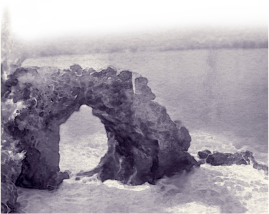 Hole In The Wall
Hole In The Wall
 Eel Brook
Eel Brook
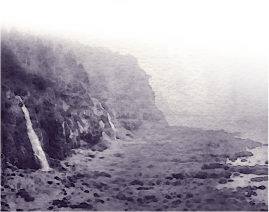 Low Tide Seven Days Work
Low Tide Seven Days Work
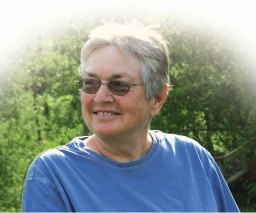
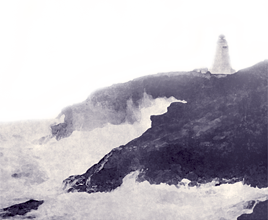 Swallowtail Lighthouse
Swallowtail Lighthouse